Last weekend I had the pleasure of exploring the MET’s Heavenly Bodies Exhibit. It is the Costume Institute’s 2018 collection on display in New York City. This is the MET’s largest exhibit to date, so large that it takes place at both the MET 5th Avenue and the MET Cloisters. If you’ve never had the chance to explore the Cloisters, this exhibition is a great excuse to make your way up there. I think seeing both spaces is vital to understanding the exhibition as a whole thought.
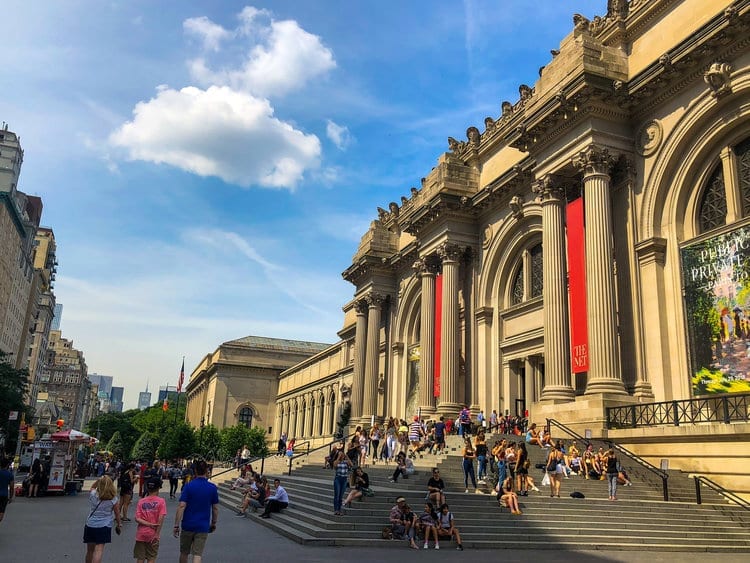

Access and Admission
The MET is open seven days a week. Sunday–Thursday: 10 am–5:30 pm and Friday and Saturday: 10 am–9 pm. To get to the MET the best way unless you’re within walking distance is to take the subway. The subway in New York is super easy to navigate and since there’s pretty much traffic 24/7 it’s much better than a taxi. The closest stations to the MET are 86 St, 77 St or 81 Street-Museum of Natural History Station.
General admission to the museum is $25 for adults; $17 for seniors; $12 for students. Your admission includes all the exhibitions and is valid for three consecutive days. It includes the Met Fifth Avenue, The Met Breuer, and The Met Cloisters. So if you’re planning on attending both the MET 5th avenue and the Cloisters just keep your sticker and receipt. That way you won’t have to pay again as long as you go within three days. You can buy your tickets online if you don’t want to wait in line. Highly recommended during these big-ticket exhibits.
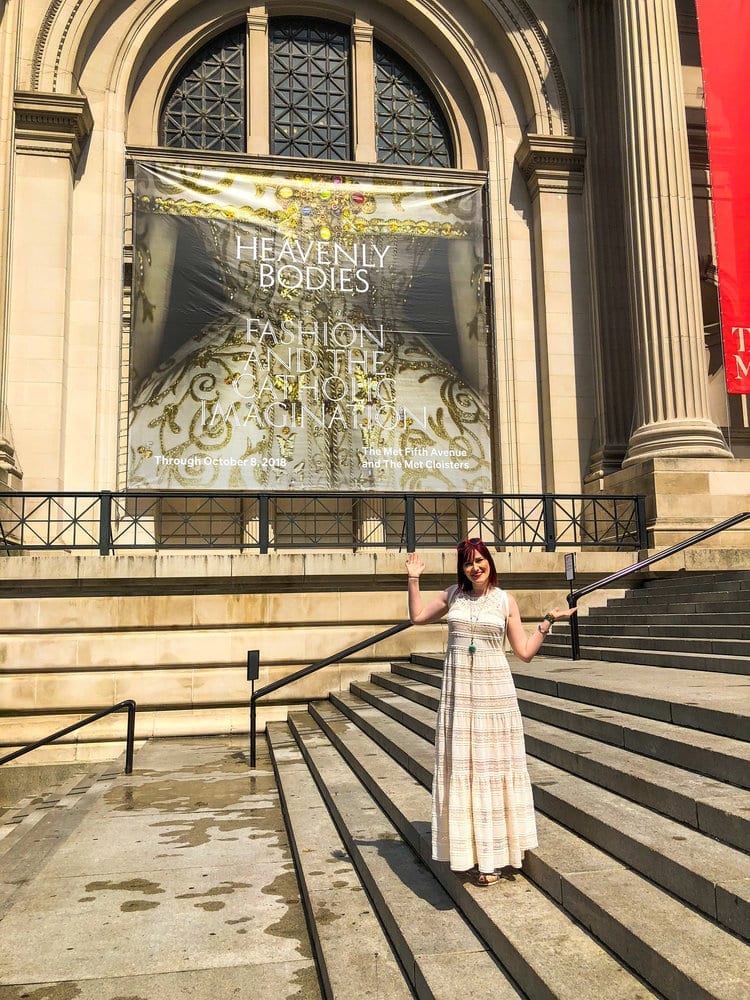
About Heavenly Bodies
Heavenly Bodies explores “fashion’s ongoing engagement with the devotional practices and traditions of Catholicism.” It investigates the influence that religion has had on the cultural imagination. As well as the ways in which it directly impacted the visions of fashion designers. Throughout the exhibition, there is no audio guide or a detailed map to direct you. I’ve created my own guided tour to help you discover what you’ll see where. I’ve broken this guide up into three different parts, to read up on the other two parts of the exhibition, click the following links: MET Vatican Collection | MET Cloisters.
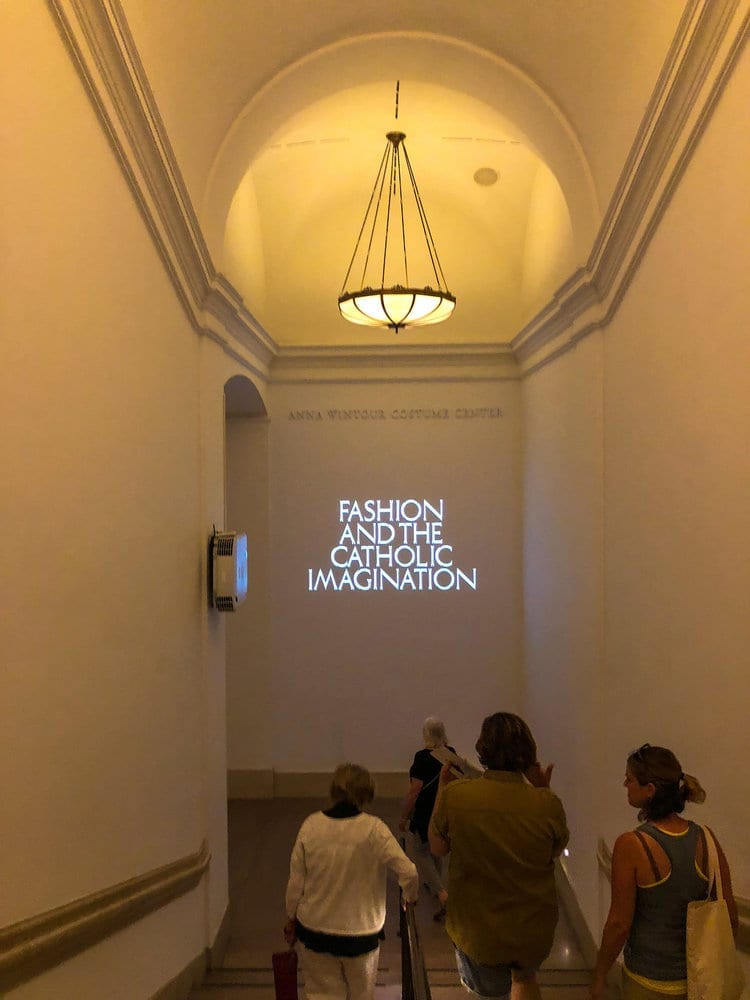
Byzantine Galleries
After viewing the Vatican Collection, head back upstairs to the Byzantine Gallery. The Byzantine Galleries focus on designers who were influenced by Sacred Spaces; the interior of Cathedrals and churches, and who brought elements from those spaces into the garments. The dresses are paired with fragments of floor mosaics from the 5th century as well as pieces of Byzantine jewellery and silverware. The mannequins each stand high aloft of tall plinths. The dresses are still clearly visible and yet are somewhat separated from the historical art along the walls.

The above Dolce & Gabbana collection was inspired by the brightly coloured tile mosaics found in the Cathedral of Monreale in Sicily. Some of the mosaics in the Cathedral date as far back as 547 AD. Portraits of iconic people from the Bible make up the mosaics on the dresses surrounded by large gemstones, allowing it to sparkle under the lights. The job of an architect when creating a cathedral was to create heaven on earth. The same kind of concept appears here in fashion. Gold thread was used along with real stones to create a garment which appears otherworldly and transports the wearer to another plane of existence. While the iconography might be antiquated, the shape of the dresses is modern and highly wearable. I was dying to just take one home with me.


Versace
On the opposite hallway to the D&G collection are rows of mannequins with bright, long blonde hair, wearing what from afar might look like medieval armour. Upon closer inspection, you can make out the large gemstone crosses emblazoned on the dresses. The fabric used to create the dress mirrors the look of chain mail. These are from Versace’s last collection in 1997. Each dress is decorated with the bejewelled crucifixes.
The collection was the last one he produced before his untimely assassination later that year. Versace struggled with his health in the years before this collection debuted. And it seems understandable how his religion would play heavily on his mind. As death seemed to creep closer and closer, even unknowingly. In adorning his dresses with the symbol of the cross, one wonders if it was some kind of absolution or confessional. To purge himself of any sin before his passing. In retrospect of his murder, the dresses are even more powerful to look at. Especially all lined up together like this.

The first gold dress in the procession with a large cross spanning the entire height and width was actually based of a real Byzantine gilt silver cross from the MET. Gianni Versace saw this cross when visiting the MET years prior and was overcome with inspiration. You can see the cross still displayed in the same gallery today adjacent to the fashions.

Wedding Dress
The last dress in the room is a beautiful wedding gown. This dress is the only one designed in silver and stands as a stunning finale piece. A veil covers the head of the mannequin and a large diamond crucifix, replete with diamonds, is placed over her face. Covering her eyes.

Byzantine Apse
In between the Byzantine hallways, in a hidden alcove, is the reconstruction of a Byzantine apse containing 6th & 12th-century mosaics as well as pieces of old Byzantine cathedrals. This little area is tucked away and many people seem to miss it. Inside you’ll find three pieces from Gianni Versace’s 1991 collection. Upon these rainbow-adorned bustiers and jackets are images of the Madonna. All set against a backdrop of original religious mosaics from the period.
In the centre is an emerald green jacket featuring the mother Mary with baby Jesus in her arms. Surrounded by a rainbow halo or jewels. Gemstones in all shapes and colours cover the entire jacket. Where there aren’t jewels, they are detailed embroidery flowing up the sleeves. The level of detail that has been placed into the creation of the jacket makes it feel more like a crown jewel. Rather than a runway look.
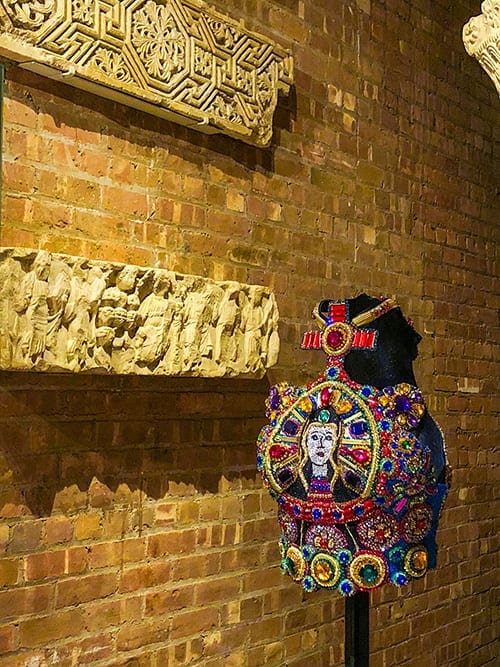


Apse Gallery
After the Byzantine Galleries, poke your head into the small Apse Gallery, located in front of the Medieval Europe Gallery. In here is one of my favourite pieces. This is Jean Paul Gautier‘s Ex-Voto gown from his Spring/Summer collection in 2007. From afar the dress looks like a blend of fashion and armour. It is covered with copper and silver plates with the images of saints and angels, as well as different bodies parts hammered into the metal. The delicate grey tulle drapes down from the sleeves all the way to the floor. She looks almost ghostly and angelic. An “ex-voto” is a religious offering.
Milagros
These are extremely popular in Mexico, where they are called “Milagros”. You purchase a different milagro which reflects the thing you’re struggling with. Hearts for someone longing for love. Images of the mother mary for something wishing to have a child, and even images of body parts to heal injuries and illnesses. These are then pinned to images or life-size statues of patron saints in order to fulfil your desires through prayer. The dress itself feels like a walking devotional. Almost as if the model herself is a vessel for all the sins of mankind.
Surrounding the dress in glass cases are a series painted icons, cross reliquaries and metalwork from the Medieval period. Each of them feels like they could themselves be a part of her dress. And all act as inspiration for the design.

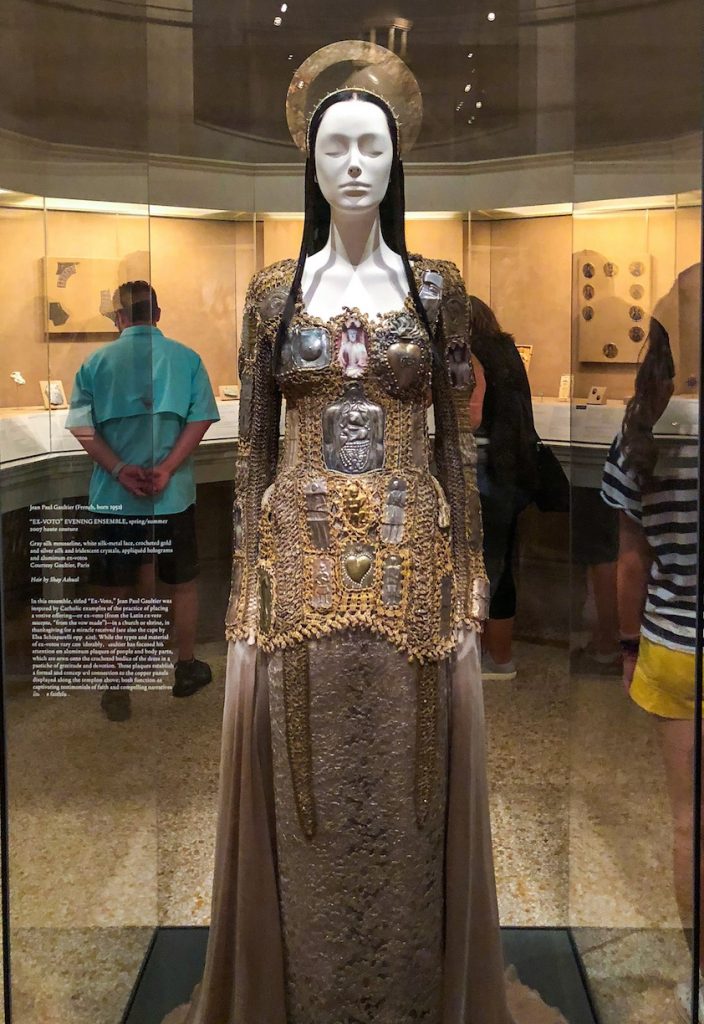
Ex-Votos
In front of the Ex-Voto dress are a series of black leather jackers. Two of them, on either end, are by a Versace, one by Gianni and the other by Donatella. Gianni Versace’s 1991 leather “Perfecto” jackets were embroidered with green, gold and ruby red Byzantine crosses. 20 years after his death, his sister, Donatella, reimagined them for her spring 2018 collection. The Byzantine cross, specifically like the ones mimicked in these jackets, are often used in processions, often during funerals. And it seems poignant to see them here, especially in Donatella’s garment as a nod to her brother after his death.
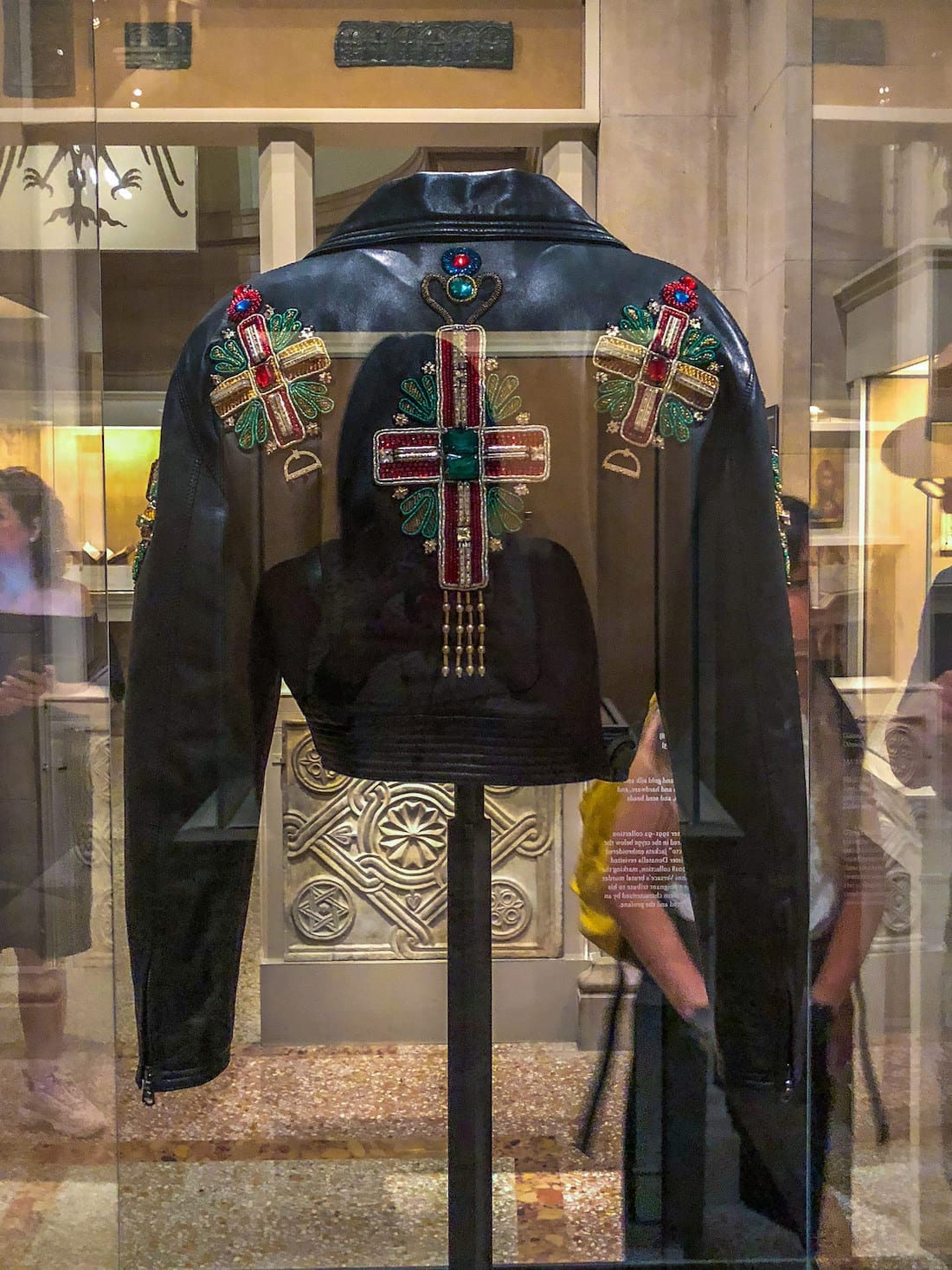
Byzantine Cross
In the centre grouping of the black jackets is my favourite, a Christian Lacroix stunner with an enormous “crux gemmata” on the front. To the right of the jacket, in a glass case, is an original crux gemmata from 1180. These crosses are covered in glass cabochons. Cabochons are rounded gemstones which have been highly polished but contain no sharp edges. The crux was the most important piece of the church’s treasury in the medieval era. These bejewelled crosses were used in large processions to usher in important parts of the Christian calendar. The use of the crux on the front of the jakcet is an impactful statment for anyone to make and the beautiful gemstones inlaid into the gold are absolutely dazzling.

Opposite the jackets are a collection of cross pendants and accessories, both from the Byzantine period and modern day. Coco Chanel owned an original copper cross pendant from the Byzantine period, lent to the MET for the exhibition, and was so inspired by its design she copied it almost identically for her collection. Chanel’s devotees loved her version of the cross pendant and wore it as a sign of their adoration for her brand. From one symbol of devotion to another, the power of the cross is universal.
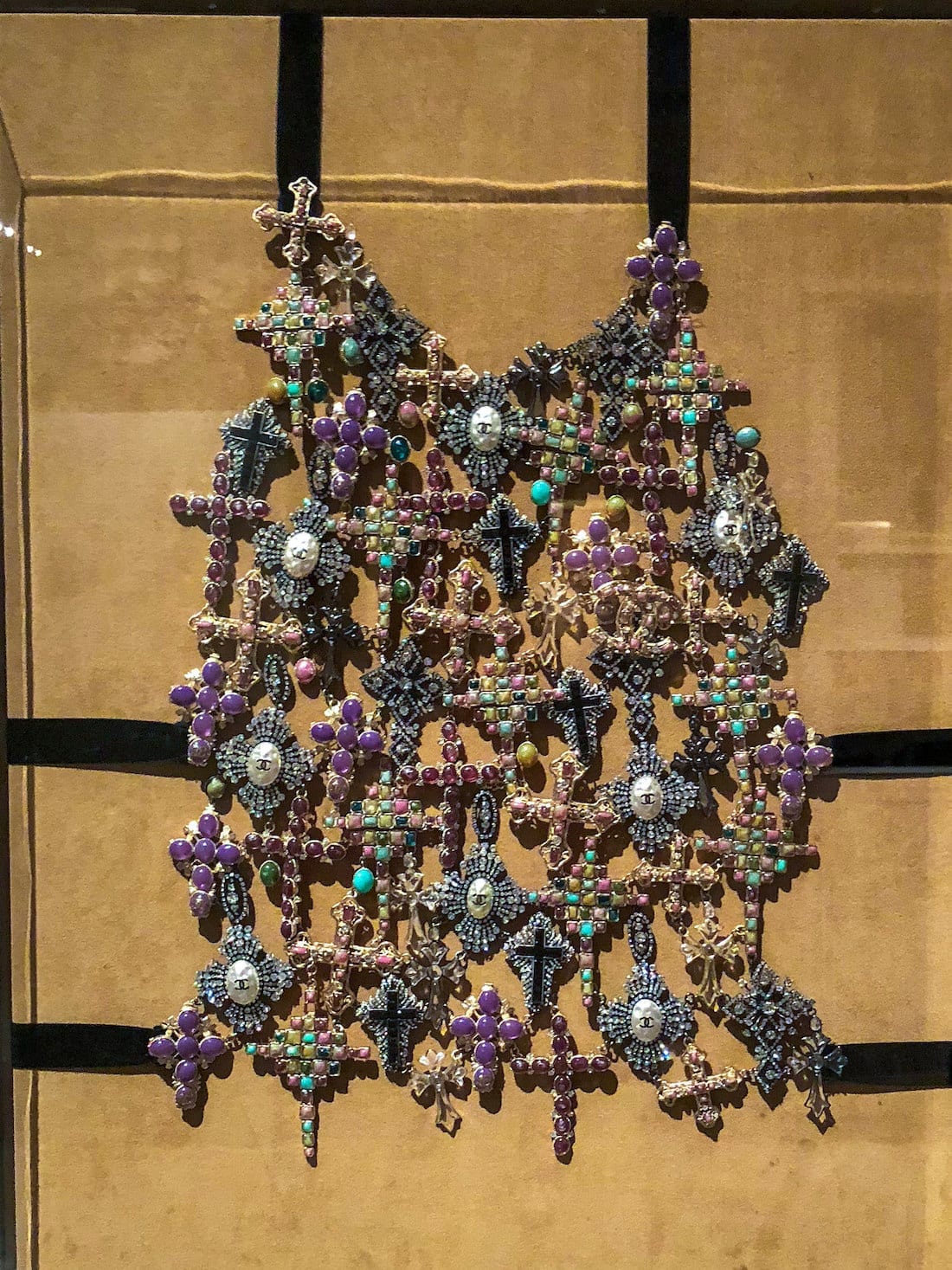
Medieval Europe Gallery
Past the Apse Gallery is the Medieval Europe Gallery. This room is centred around a large marble altar canopy from the 12th century. Around the perimeter of the room are some gorgeous original stained glass windows, making you feel as if you have entered a part of the church. The Medieval Europe gallery focuses on designers who created garments for saint statues inside churches, specifically for the virgin and child.
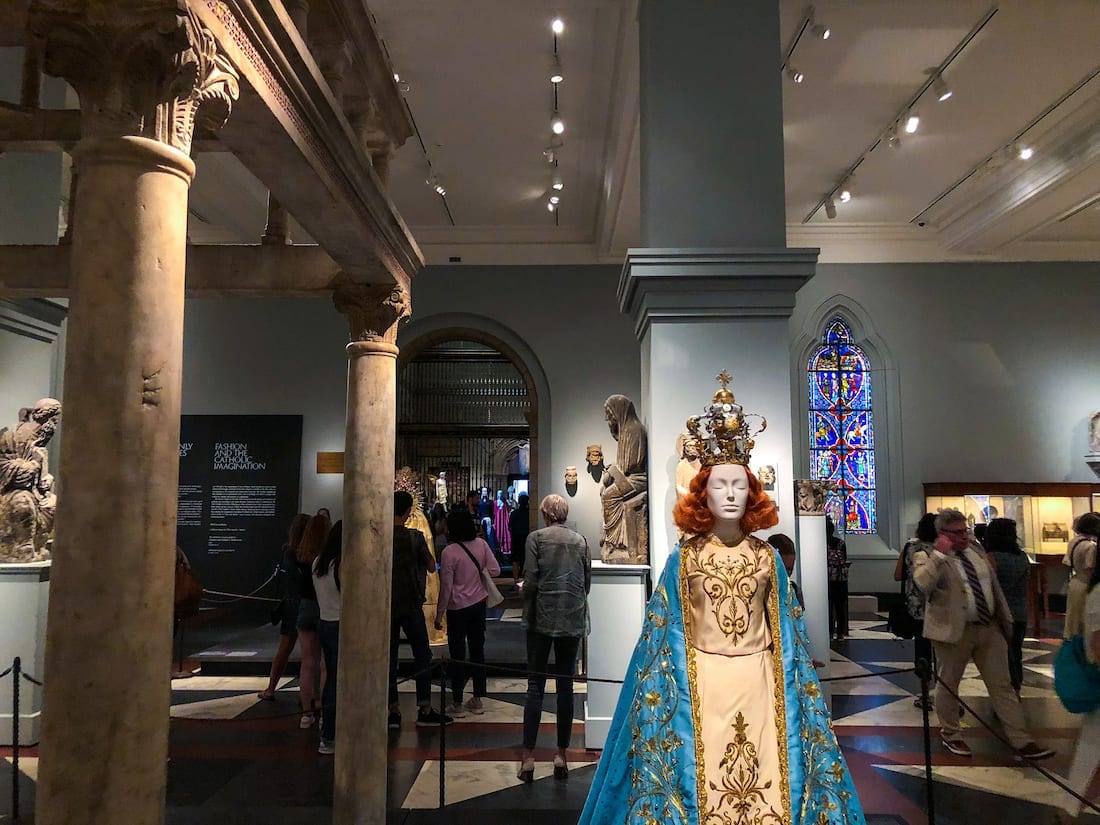
Located beside the marble altar is a stunning dress in ivory with a sky blue cape embroidered all over with gold threads designed by Riccardo Tisci. Dressing sculptures is a tradition that dates back to the middle ages. Wooden statues made to appear like important saints were carried in ceremonial processions and adorned with costumes and votive offerings. During different times of the year, the statues would be dressed differently to signify the change in the religious calendar.
Chapel of Our Lady of Compassion Dress
The blue and cream dress was designed as a vestment for the Madonna in the Chapel of Our Lady of Compassion in Paris. It is a reworking of an original design once worn by the saint in the 1500s. The first dress was made by the Sisters of the Order of the Poor Benedictine. It was hand embroidered and took over 3,000 hours of labour to complete. This led to a papal order in 1530 to ban such lavishness and excess since it was considered immoral and indecent. Thankfully, hundreds of years later we don’t just see this lavishness as a sin but rather as a testimony to the importance and love people have for the Madonna. They want to adorn her with treasures and make even images of her form as heavenly as possible.
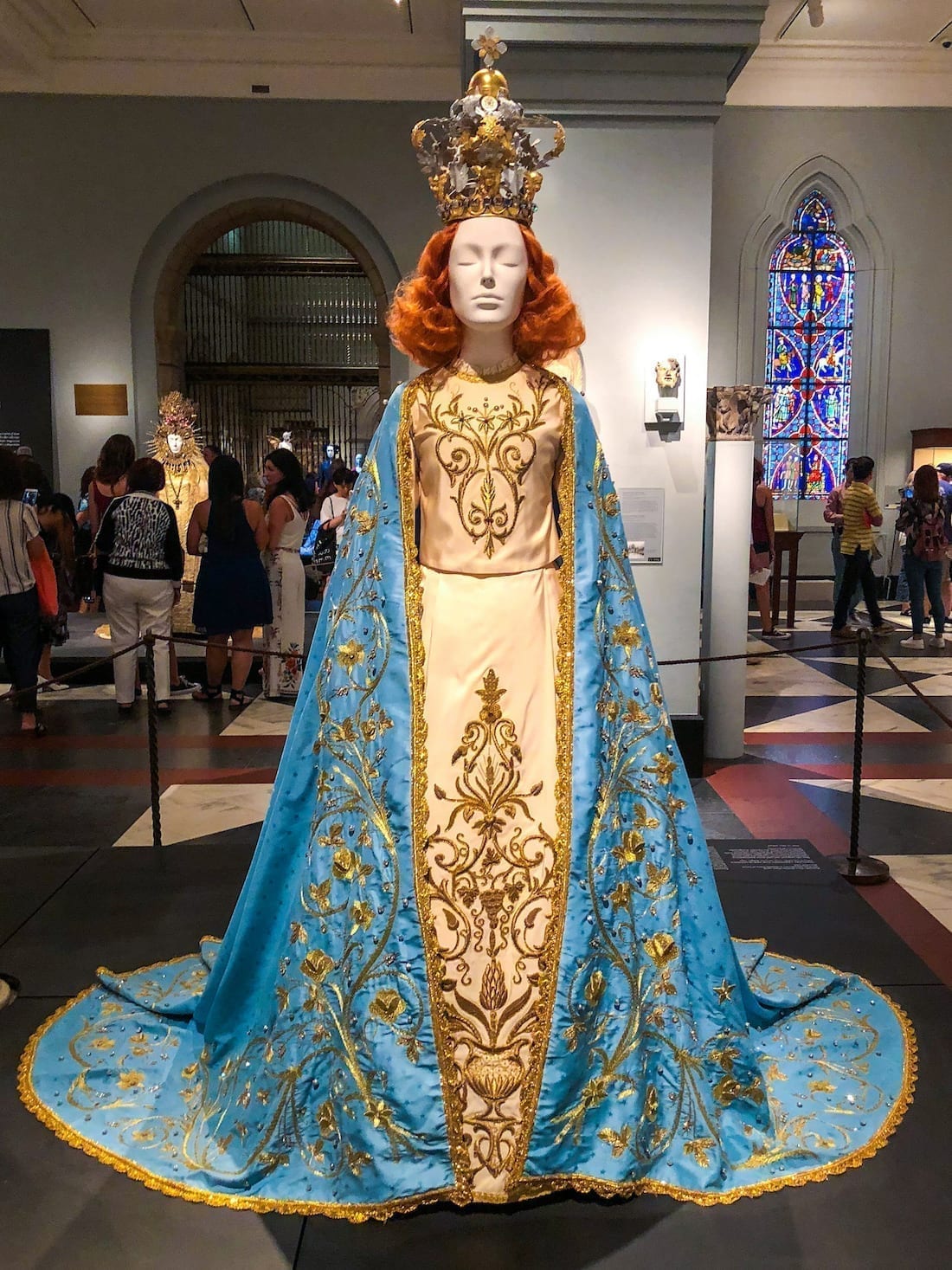
The other stunning figure in the room is inspired by Our Lady of Guadalupe, popular mostly in Spain. The outfit, designed by Yves Saint Laurent, was also inspired by the statue of the Virgin Mary atop the spire of Milan’s cathedral. Our Lady of Guadalupe is iconic for the presence of her ornate crown and rays of light which emanates from her body. Gold is such a highly symbolic colour for the church. It symbolizes majesty, joy, and celebration. Her crown here is made up of gold coral. During the 18th century coral was one of the most precious treasures and since the seas were as of then so unexplored, it was almost mythical. By creating the Virgin’s crown from gold coral it is elevating her majesty to an almost fantastical level.
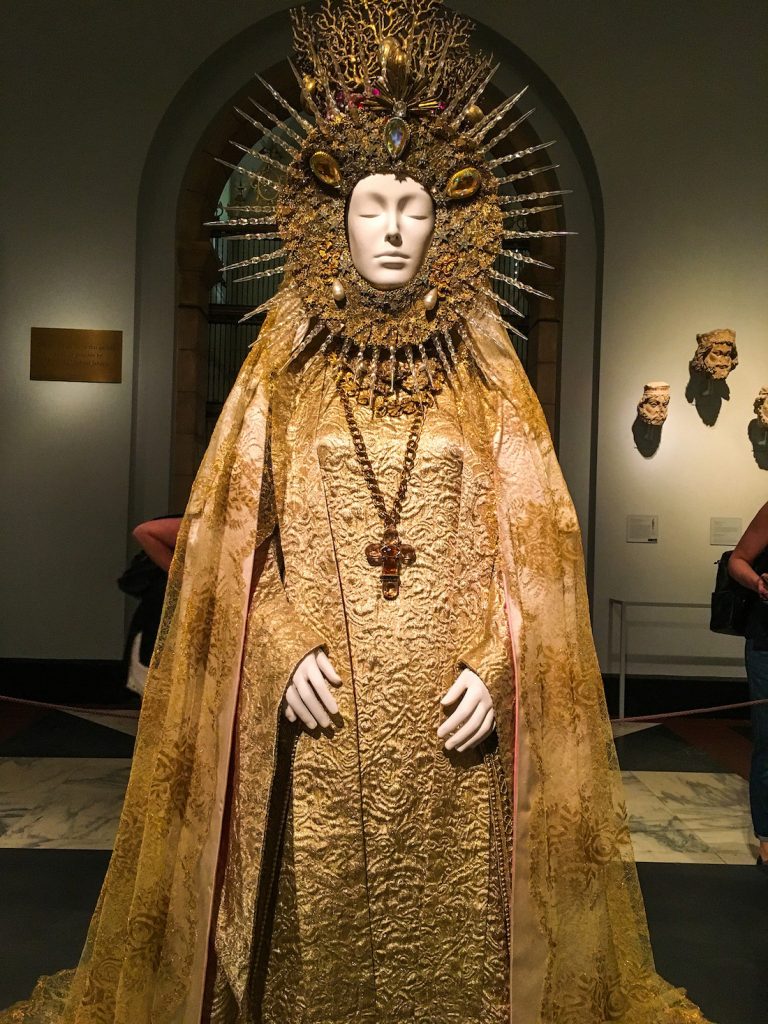
Medieval Sculpture Hall
Walking into the sculpture hall, you truly feel like you’re walking into a Medieval Cathedral. The layout is similar to that of a traditional church with a nave, central aisle, two side aisles and an enormous three storey choir screen. These choir screens were used before reformations to create a distinct barrier between the divine and the earthly plane, where the common people prayed and where the priests preached. In this room they even have choral music playing throughout, giving the space that extra air of gravitas.
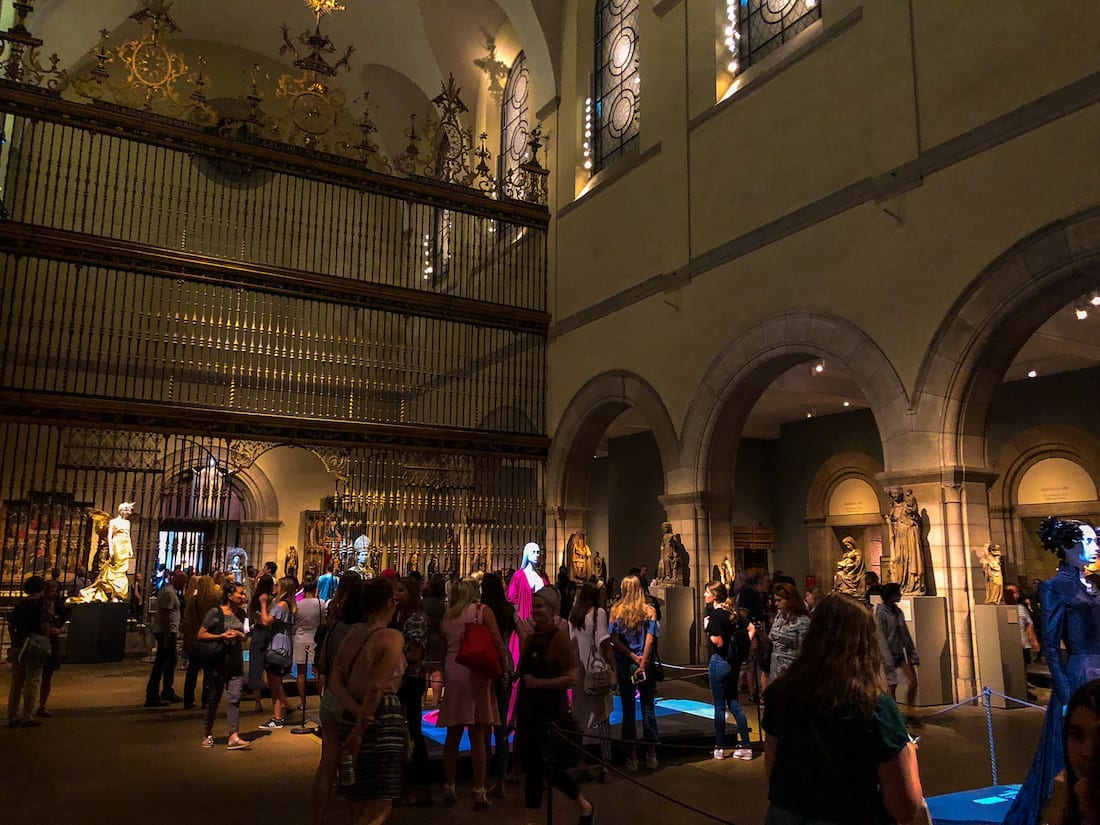
Monks & Nuns Garments
In the exhibition, the choir screen is used to divide fashions inspired by the nuns and clergymen and the garments inspired by holy saints and angels. The left aisle is dedicated to fashion inspired by priestly robes and monks garments. One of the most iconic pieces of the ecclesiastical dress is the black cassock or soutane. This is the uniform most people would recognize as a priestly garment. These soutanes inspired many different fashion designers over the years.

Other than the black soutane, nun’s are distinguishable by their white veils. The wearing of these veils is derived from a biblical commandment which states that “every woman praying or prophesying with her head uncovered disgraces her head” -First Corinthians 11:3. These veils became a source of huge inspiration for designers due to their structural shape and distinct silhouette they give to the body.
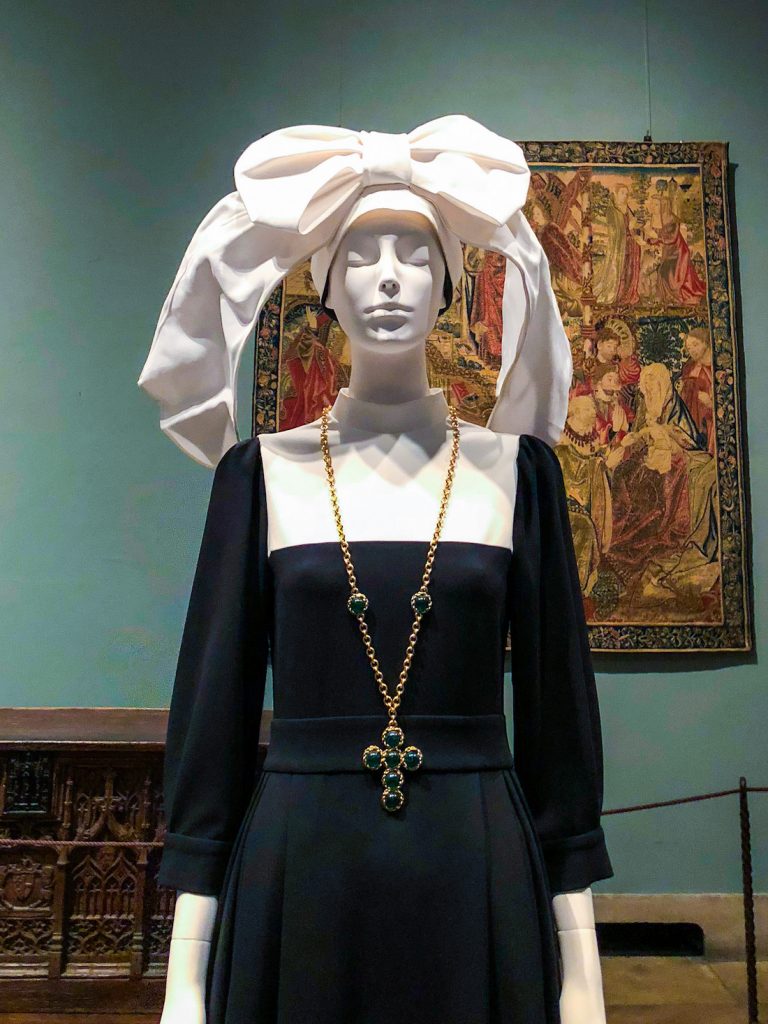
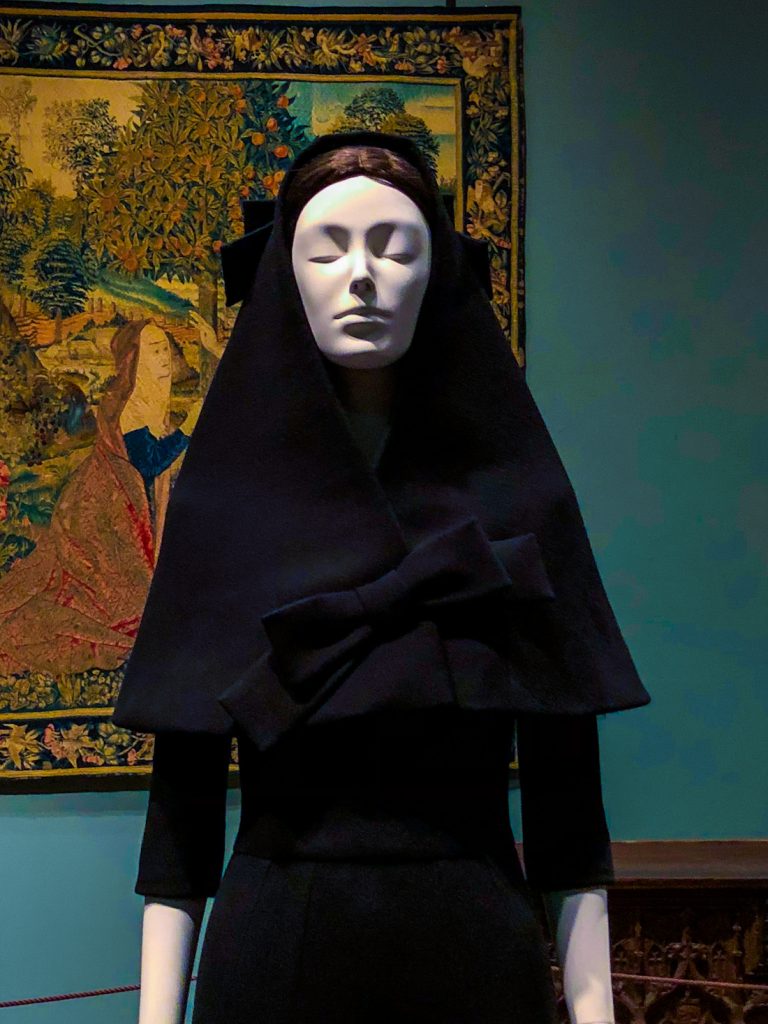
Godelieve
One of the MET’s most impressive medieval paintings is the multi-panel depiction of the life and sainthood of Godelieve. Godelieve was a pious young girl who wanted to devote her life to god and become a nun. Her mother and father, however, wanted her to marry a wealthy nobleman. She was forced into the marriage but before the wedding could take place she fled.
Two servants caught her but when they brought her back, her husband demanded the servants throw her into a pool. There she drowned and the husband pretended her death was by natural causes. Her husband married again but their first daughter was born blind, as his new wife Edith was cursed by Godelieve. To repent, they both set off on holy pilgrimages and each founded a Monastery and Abbey respectively. Many of the garments in this historic painting can be seen as almost direct references to the fashions on display.
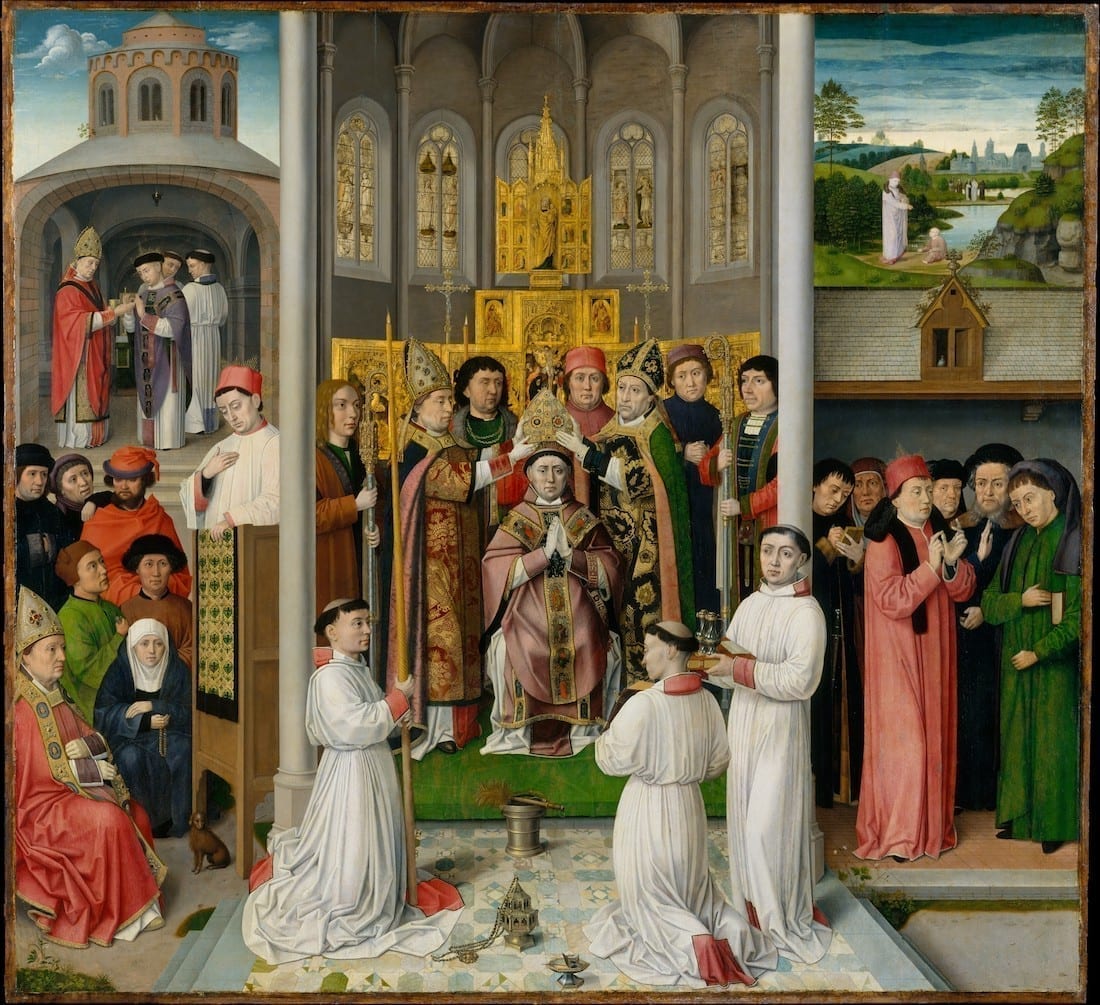
One of my favourite outfits was designed by Jean Paul Gautier in 1997. The design is all black, much like the priest’s cassocks but in the centre of the dress, there is a small beaded image of the mother Mary. On either side of the image are two wings which can be opened and closed around the figure. This mimics the layout and function of medieval triptych paintings. Similar to the three panel layout of the painting of Godelieve above.
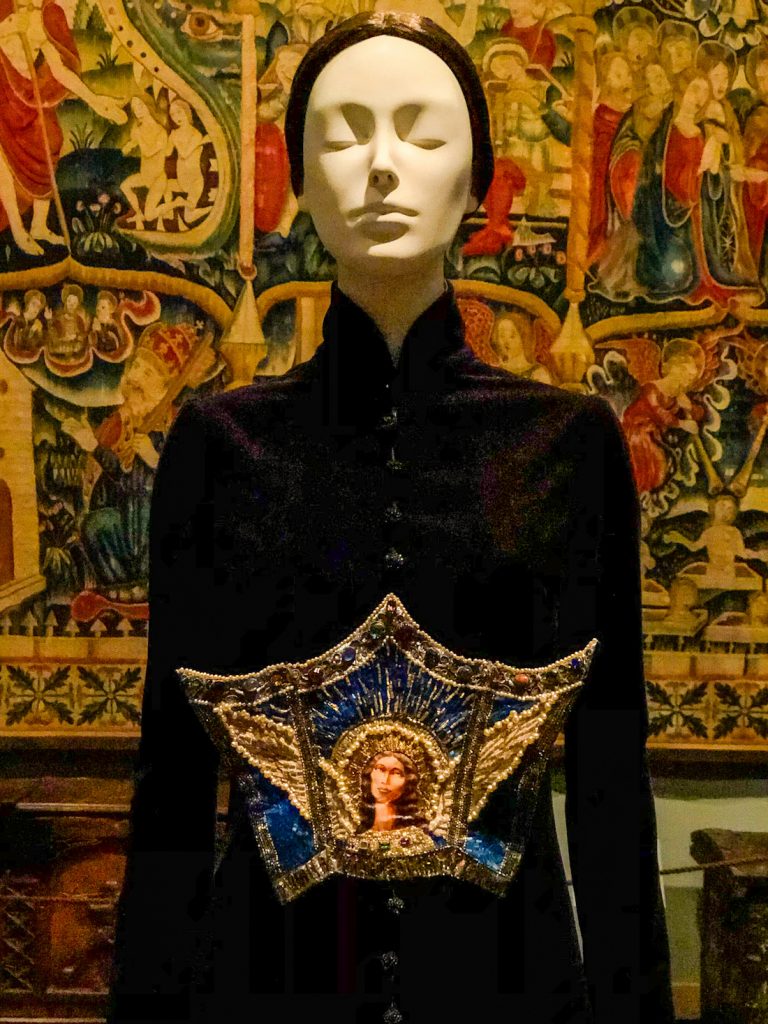
White & Gold
Colour is very important in the Catholic church to establish hierarchy. The pope is almost always dressed in white and gold. White symbolizes purity, holiness and virtue. Gold thread is brilliant and sparkles in the light and as such, symbolizes the presence of God. No better example of the elevated nature which white and gold embues is this brilliant piece by the House of Dior, designed by John Galliano for their haute couture collection.

Priests, bishops and nuns all wear black as it is a symbol of repentance and simplicity. Bishops’ robes can be distinguished from the priests by the red trim. They call this colour “amaranth” named after the flower from which the dye was derived from. Amaranths are a flower which seems to bloom all year long and therefore has become a symbol for immortality.

Cardinals
Cardinals wear long red robes. Red is the colour of princes, as they act like the princes to the kingdom of God. Red also symbolizes the blood of martyrs. This Valentino gown was designed to look like the great cape or “cappa magna” worn in processions by cardinals. Valentino’s interpretation here marries modesty and sex appeal with that severe plunging neckline but use of layers upon layers of fabric.
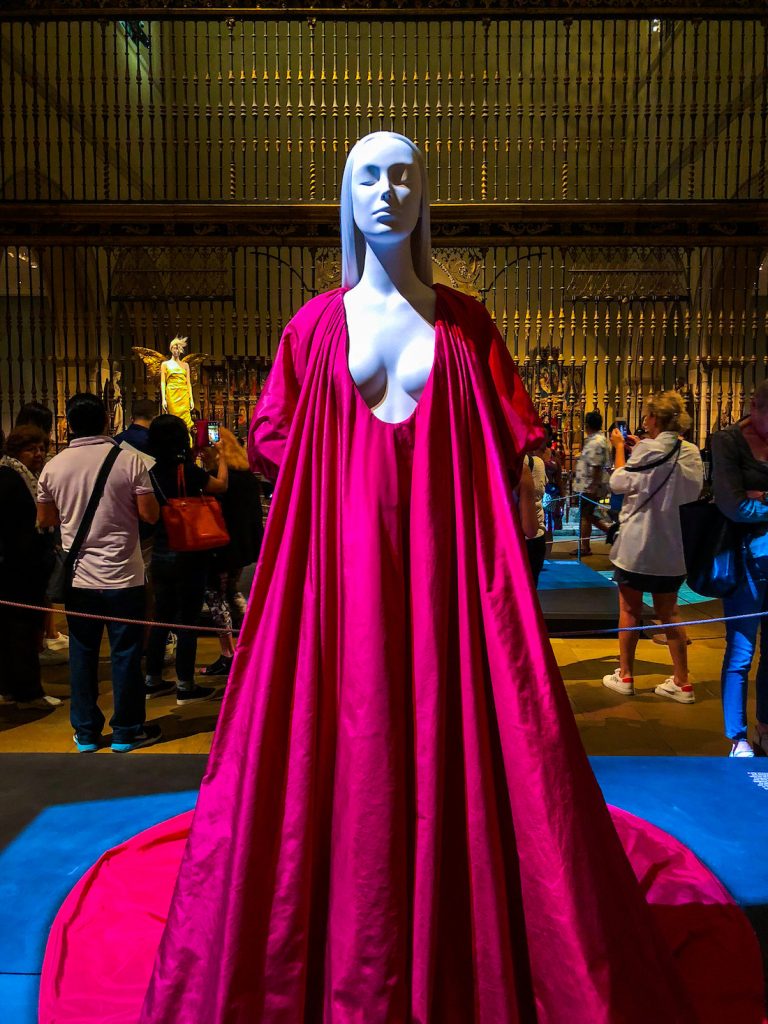
Some of the outfits here mimic the look of the traditional monastic vestments so much, upon first glance you might assume they are the real thing, albeit with perhaps a few alterations and luxury fabrics. One such gown caused an uproar when it first came down the runway in 1956. The “Little Priest” dress was designed by Sorelle Fontana and made famous when it was worn by Ava Gardner in their Cardinal collection. It is directly influenced by a cardinal’s soutane, even down to the red trim and long gold cross.

The Sound of Music
Thom Browne‘s womenswear collection inspired by the Sound of Music plays with the monastic looks as well. It is often surprising to see these modest and relatively refined elements of these vestments in women’s fashion where dressing is often shockingly provocative and revealing. It is perhaps the departure from a more alluring look to this structured, put together appearance which made these collections so poignant for modern women.
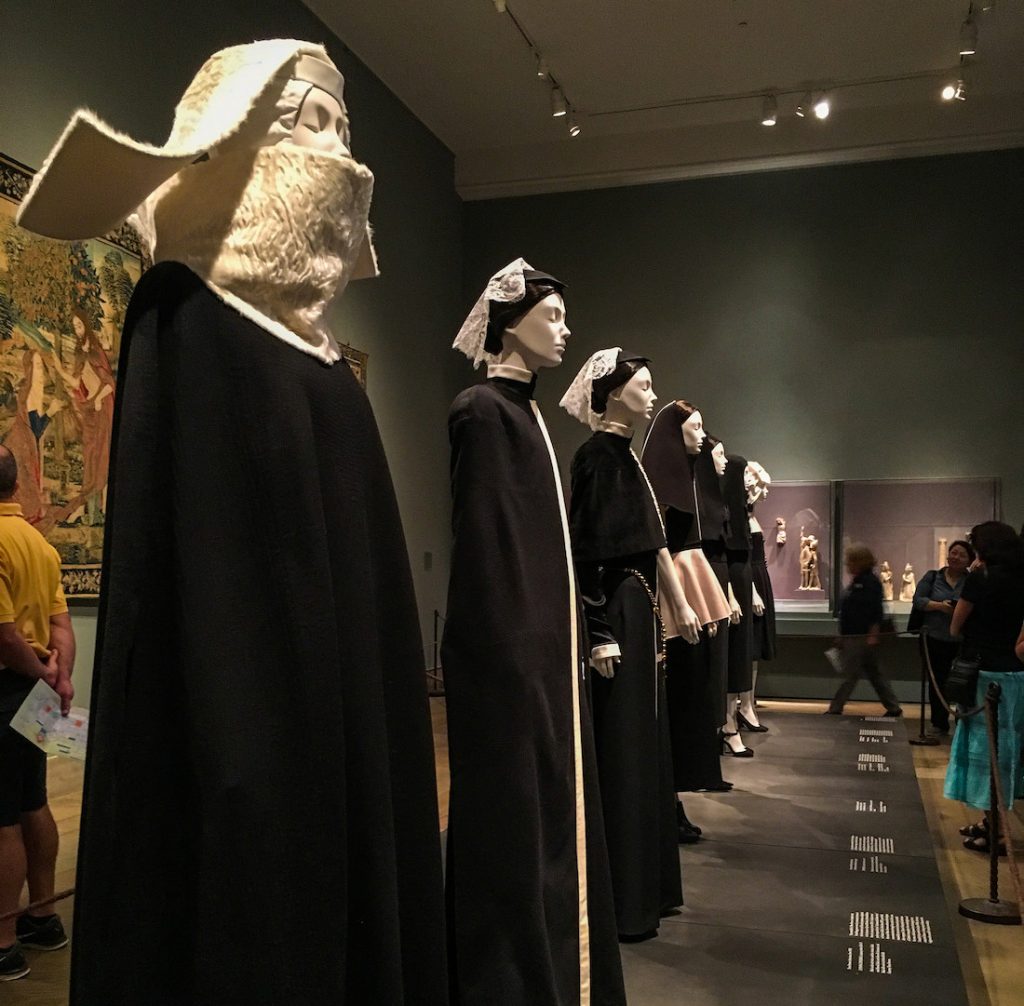
Standing at the entrance to the choir screen, turn around and look up. The balcony inside the room is filled with mannequins, each wearing a simplistic, white choir gown. These were designed by Balenciaga in the 1960s. He was inspired by the uniforms of his seamstresses in his studio who were also members of the choir. He donated the garments to the church and they are on loan here, standing in the spotlight. Many people seem to miss this one part of the exhibit so be sure to take a moment to observe it.
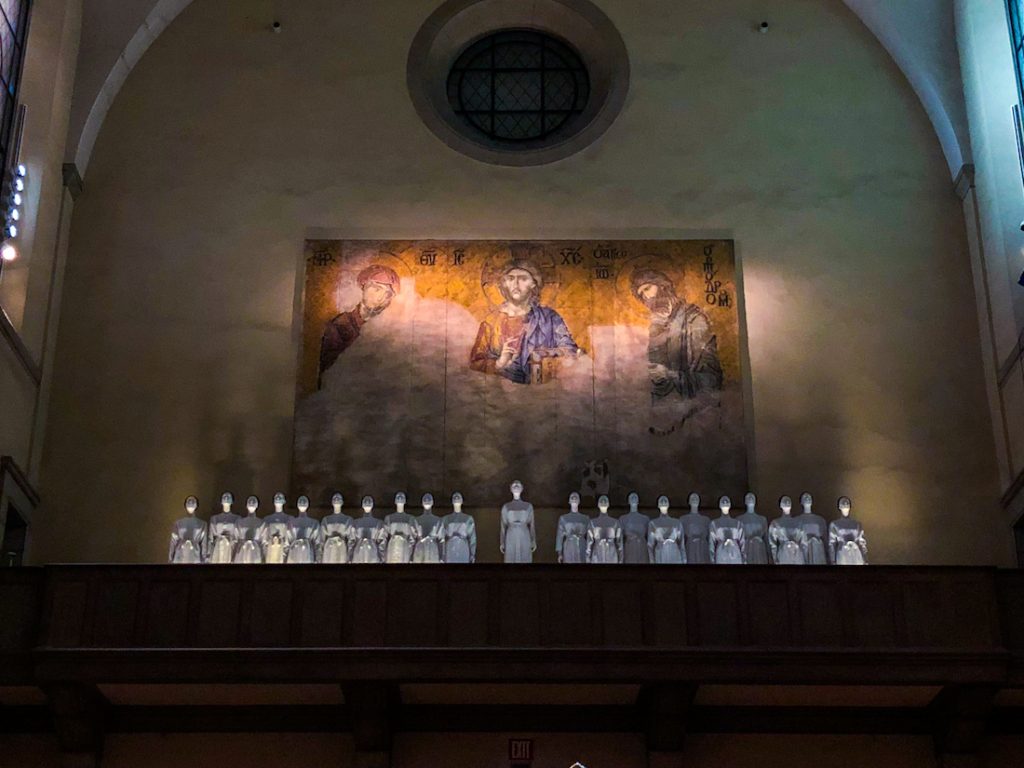
Saints and Angels
Behind the choir screen, we enter the realm of the divine, with garments inspired by the cult of saints and angels. At the entrance, you’re greeted by the gold-clad angel designed by Mugler in 1984. The angel was based on iconic images of the Arch Angel Gabriel. The delicate drapery, pooling around the body feels almost ethereal. He is the perfect welcoming figure as you make your way into the heavenly realm.
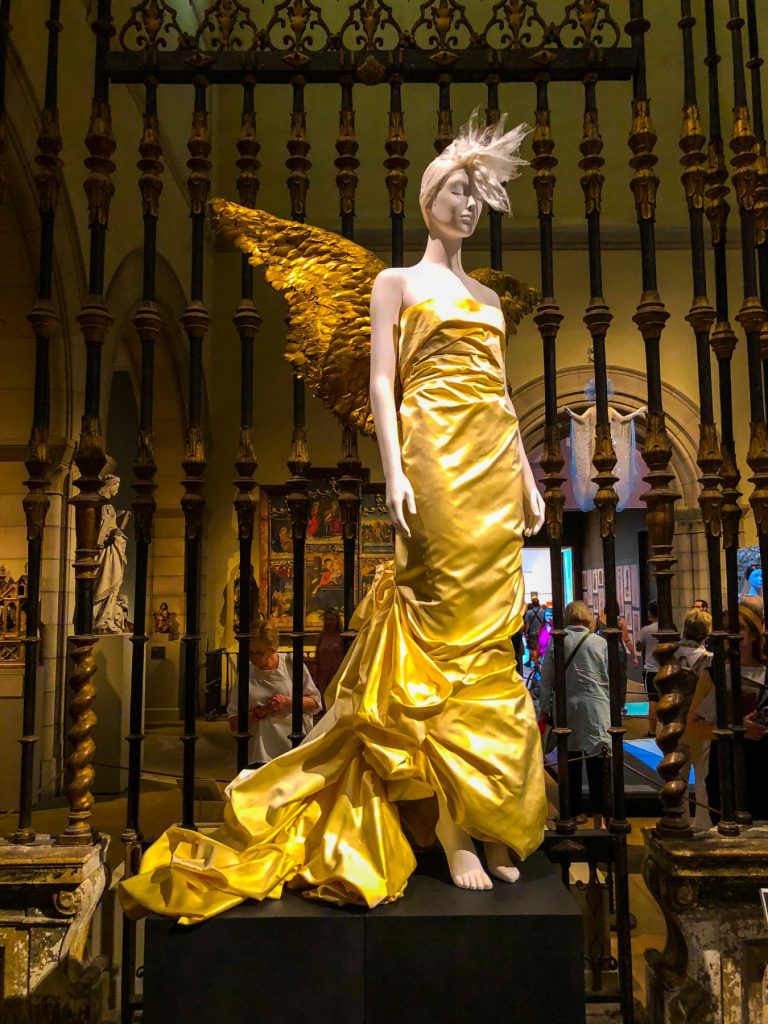
In front of the choir, screen stands a heartstopping model wearing what appears to be a wedding gown, covered in flowers. In the middle of her chest is a copper heart with a dagger struck through the centre. This is a dress designed by Christian LaCroix, made to be the show-stopper in his 2009 collection. And one can understand why. Her outfit resembles the image of the Immaculate Heart of the Virgin Mary.
Immaculate Heart
There are so many levels of symbolism in the Immaculate Heart, it is one of my favourite images in Christian symbology. The heart being visible outside Mary’s body symbolizes her undying love for the people, so powerful her heart cannot be contained in her body. A row of roses surrounds the heart, roses are a symbol of purity relating to her immaculate conception. Finally, the heart is pierced by a sword symbolizing the eternal sorrow she has for the child she lost. Whether you are religious or not, there is certainly something deeply moving about a mother’s pain for the loss of her child. LaCroix’s dress takes elements from this symbol and threads them into the literal fabric of the dress.

Mugler
Blue and white together are traditionally the two colours associated with the Virgin Mary. In many medieval paintings, she is seen clothed in a blue robe, blue the same colour as the sky, to symbolize her position as the queen of heaven. White is also the symbol of virtue and purity which exemplify her virginity. In 1984, Mugler‘s famous runway featured an audience of over 6,000 spectators and combined fashions with theatrical sets, music, and choreography. The culmination of the show ended with actress Pat Cleveland descending from the ceiling in a wash of dry ice above a series of glass spires. She was adorned in an outfit designed as a modern-day Madonna complete with the same blue and white robes seen in medieval paintings.
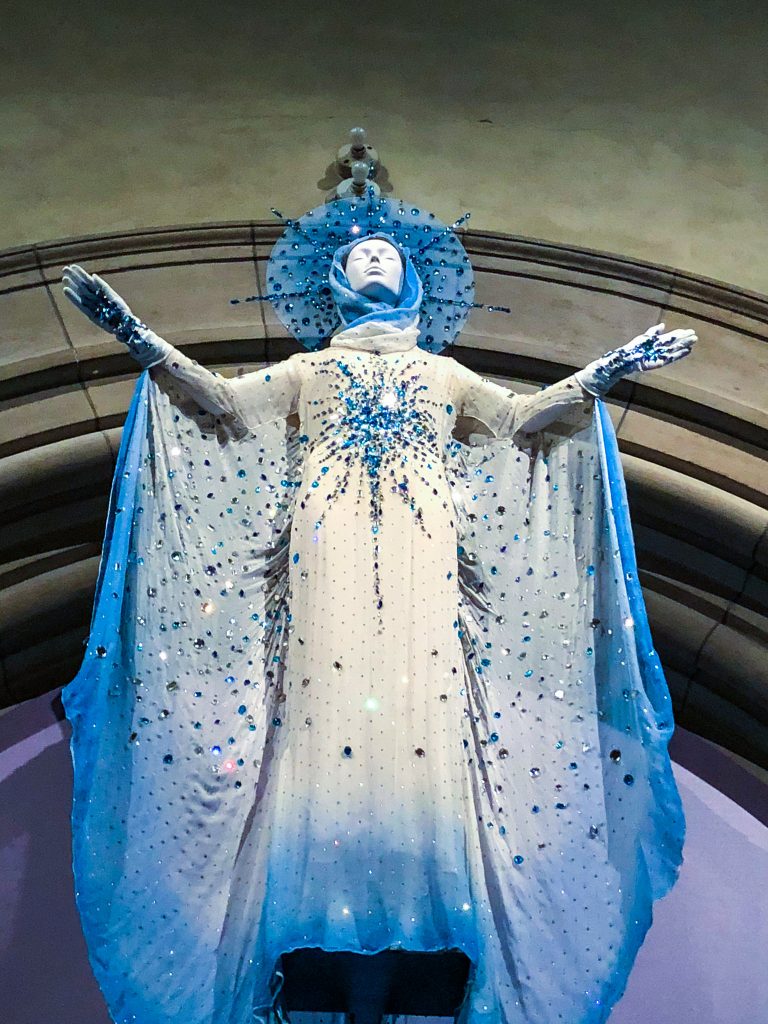
On either side of the choir screen are two figures lying in repose. The one on the right is a medieval effigy of a royal knight. He is seen wearing his armour and holding his sword in his hands. On the opposite side is a dress by Jean Paul Gautier from 1994. The dress is a simple, yet beautifully constructed, linen gown with the addition of an immaculate embellished shoulder piece which resembles armour. The design of the outfit feels like a reference to Joan of Arc as well as the medieval sepulchre art found opposite.
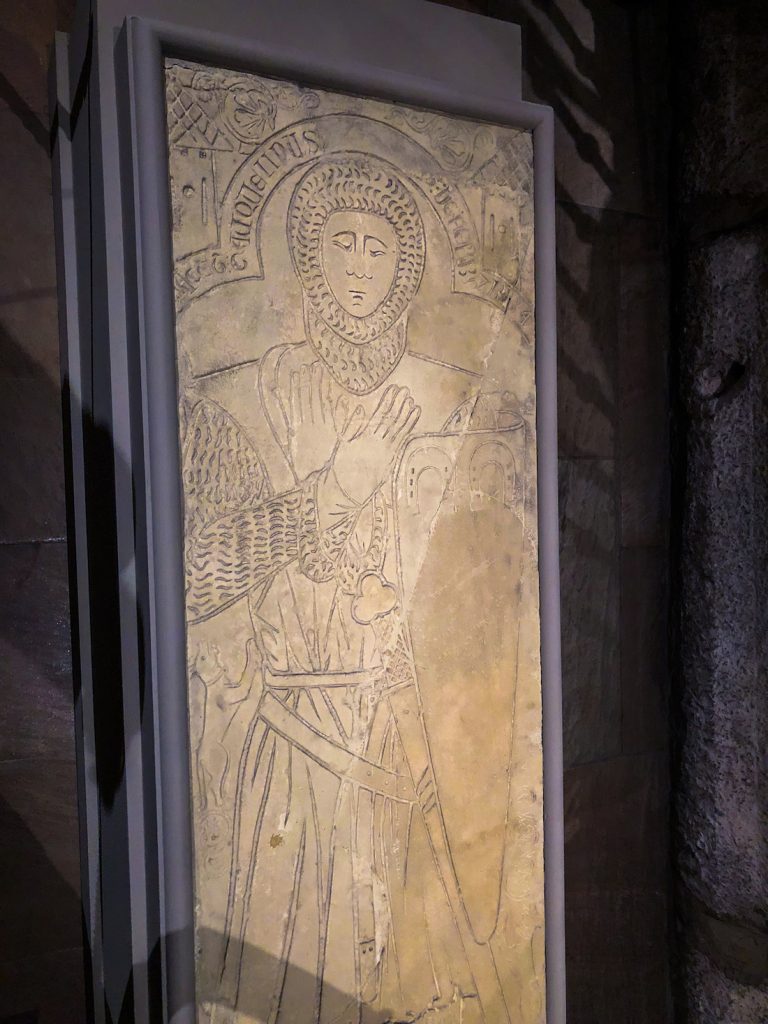
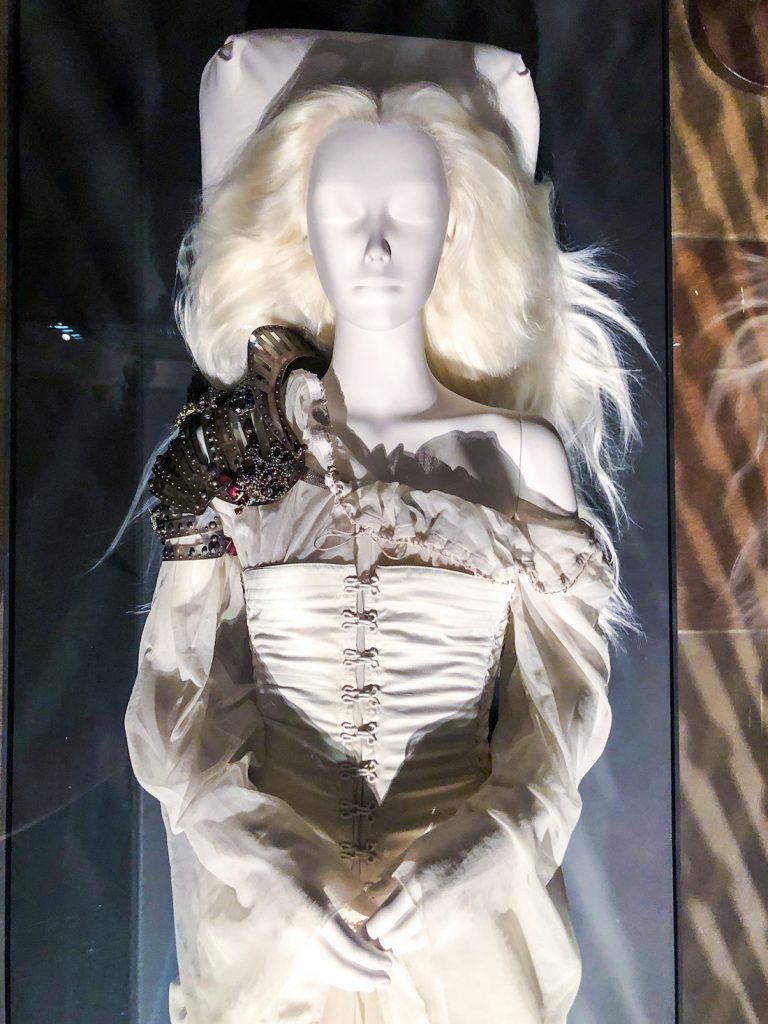
Medieval Treasury
The Medieval treasure contains various works from the Gothic period in France. Stained-glass panels, carved ivories, manuscripts, and goldsmiths’ work are all lovingly displayed along with accessories from the Heavenly Bodies Collection. The first piece you’re greeted by is the iconic wooden angel wings by Alexander McQueen. McQueen’s angel with plywood wings is set against the backdrop of a 14th-century wooden altarpiece. Both depict angels carved out of wood, but their take on the biblical creatures each reflects the cultural sensibilities of the time.
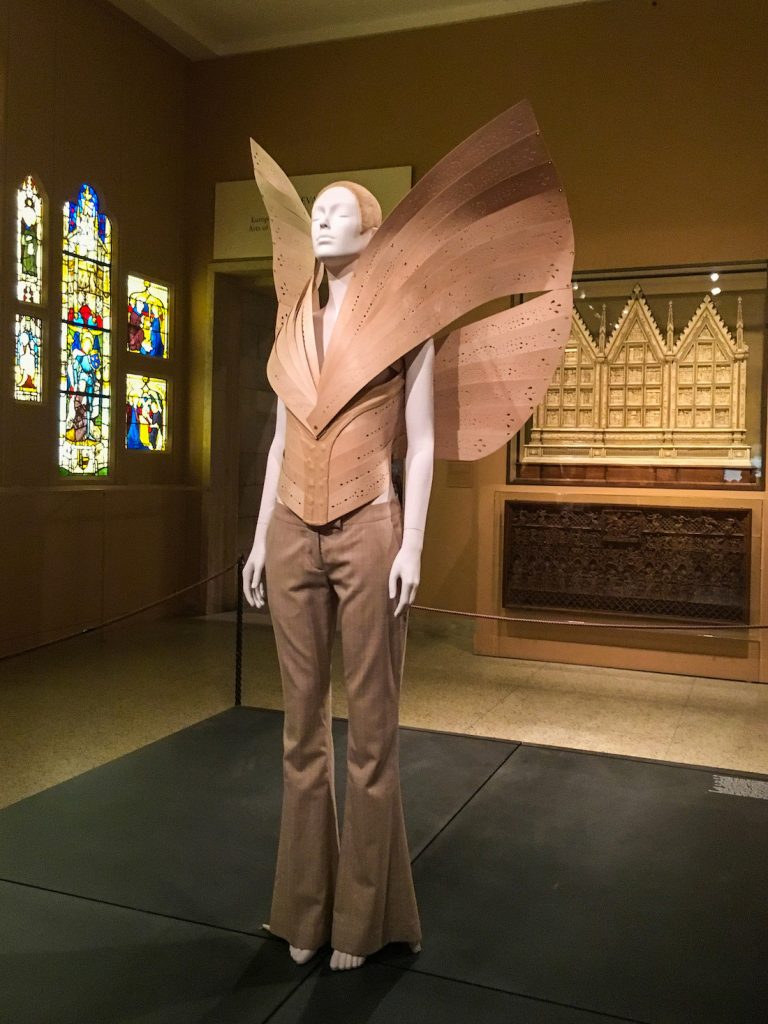
Crown of Thorns
A gothic headpiece by Givenchy covered in garnet rosary beards is set beside a gothic stone carving of Jesus with the crown of thorns. The Gothic subculture was prevalent in modern fashion in the 80s and 90s. The connection between goths and Catholicism is actually very tightly knit. Gothic fashion derives much of their influences from Gothic Cathedrals. The ornate gold and silver crosses, the embellishments and the black-clad uniform much like the same ones worn by priests.
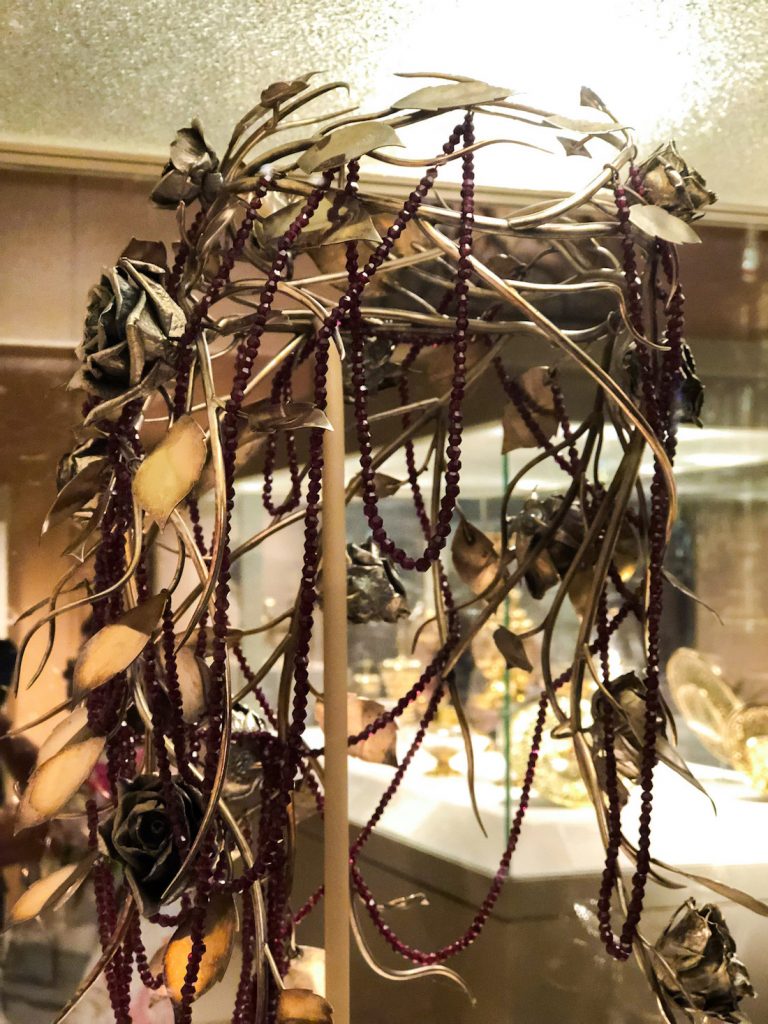
The Robert Lehman Collection
After touring the rest of the accessories in the treasure head across the courtyard to Gallery 955 in The Robert Lehman Collection. The Lehman collection is home to nineteenth and twentieth-century European paintings. During Heavenly Bodies it contains a small grouping of angelic fashions in a spectrum of colours. These are a collection from Rodarte and the House of Lanvin. These women dressed in heavenly robes inspired by one of histories greatest artist, Fra Angelico. Fra Angelico was an early Italian Renaissance painter described by Vasari in his Lives of the Artists as having “a rare and perfect talent”. The colours used throughout his pieces came to define renaissance painting.
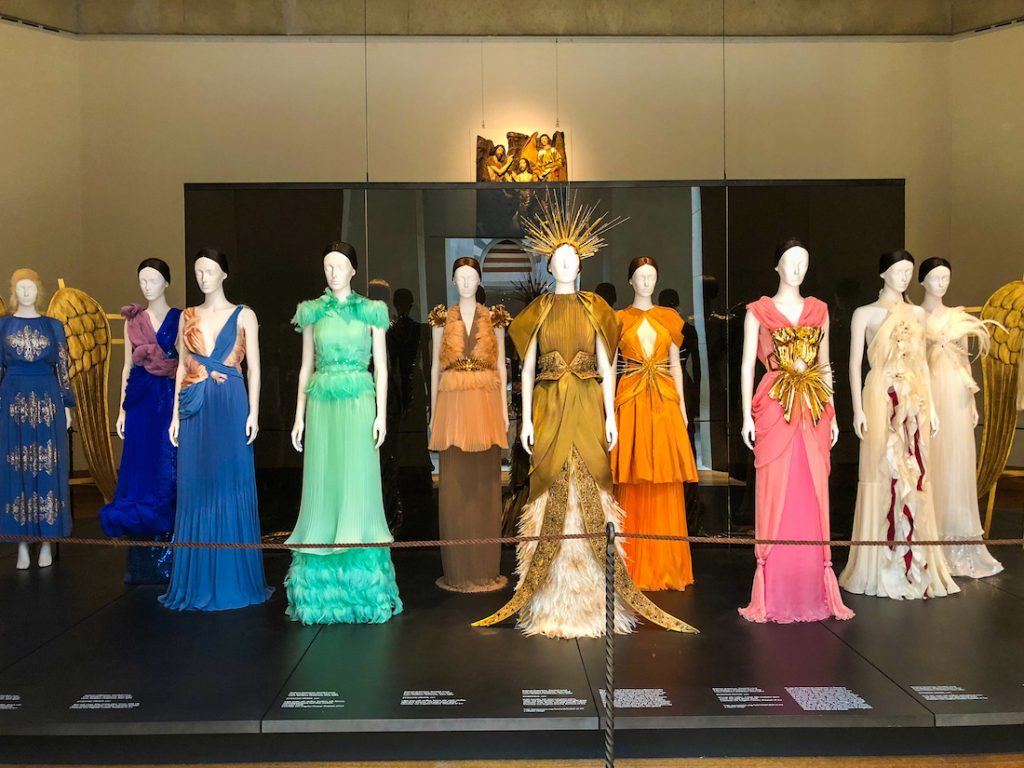
The blue dress with golden embellishments is lifted straight from the canvas of Fra Angelico’s frescos. In fact, Lanvin was so awe-inspired by Angelica that they copied some of the depictions of garments from the frescos almost exactly for their collection. Prooving that even centuries don’t separate what people see as beautiful, even in fashion.

Rodarte
To the right, is a collection of golden figures with radiating headpieces by Rodarte from 2011. This dress is an interpretation of Bernini‘s emotional “Ecstacy of Saint Thersa” in Rome. Looking at them together one can clearly see the inspiration but even without them side by side, it is impossible not to feel the brilliant power of the dresses alone.


Behind the rainbow collection is a set of dresses once more from Mugler‘s 1984 collection as well as a few pieces by Roberto Capucci in 1987. These dresses are made of delicate metallic fabrics which have been carefully pleated and draped into silhouettes of angelic figures. The peaked shoulders form the appearance of wings. They almost look like golden statuaries and yet with the slightest breath of wind their seemingly solid forms gently bend and sway.
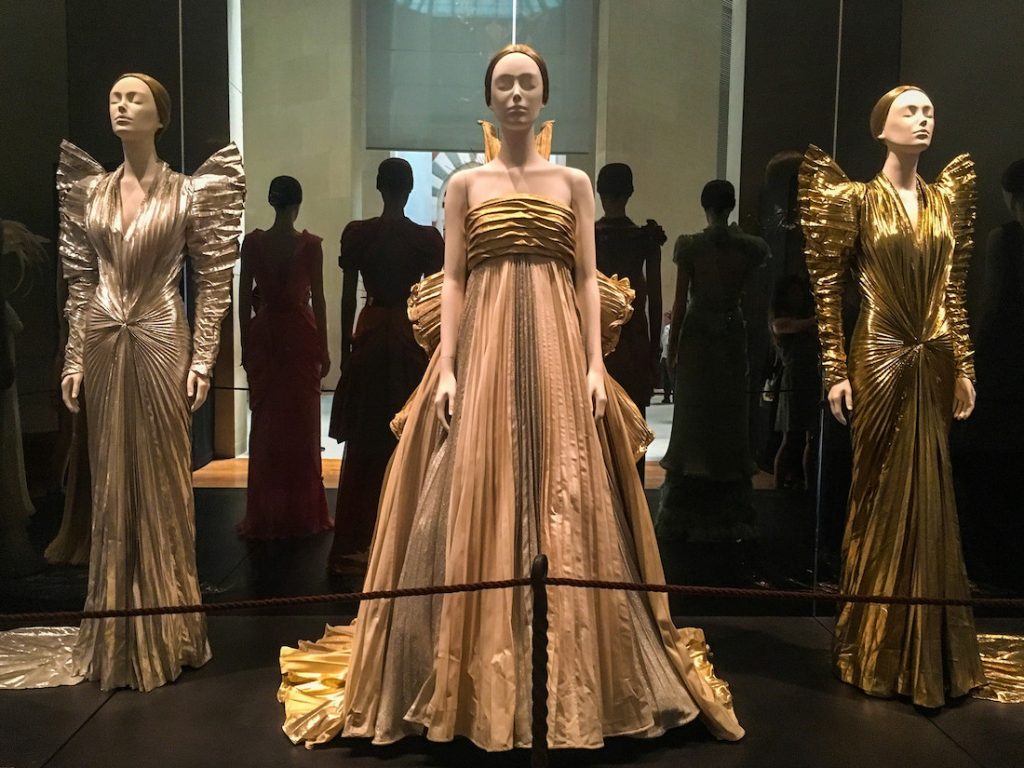
This completes your journey through the MET 5th Avenue Collection of the Heavenly Bodies Exhibit. But the adventure is not over just yet. Andrew Bolton, the curator of the exhibit, designed it to be like a pilgrimage. And to see the entire vision, you must next travel out to the MET Cloisters to see the final instalment. Having seen the MET Cloisters exhibit I must implore you to do the same, and if you can’t make it out there, be sure to read my guide, because it truly is such a powerful and significant part of understanding the entire exhibition. The show is on until October 8th, 2018, so even if you don’t make it out there right away, be sure to see it before it ends!

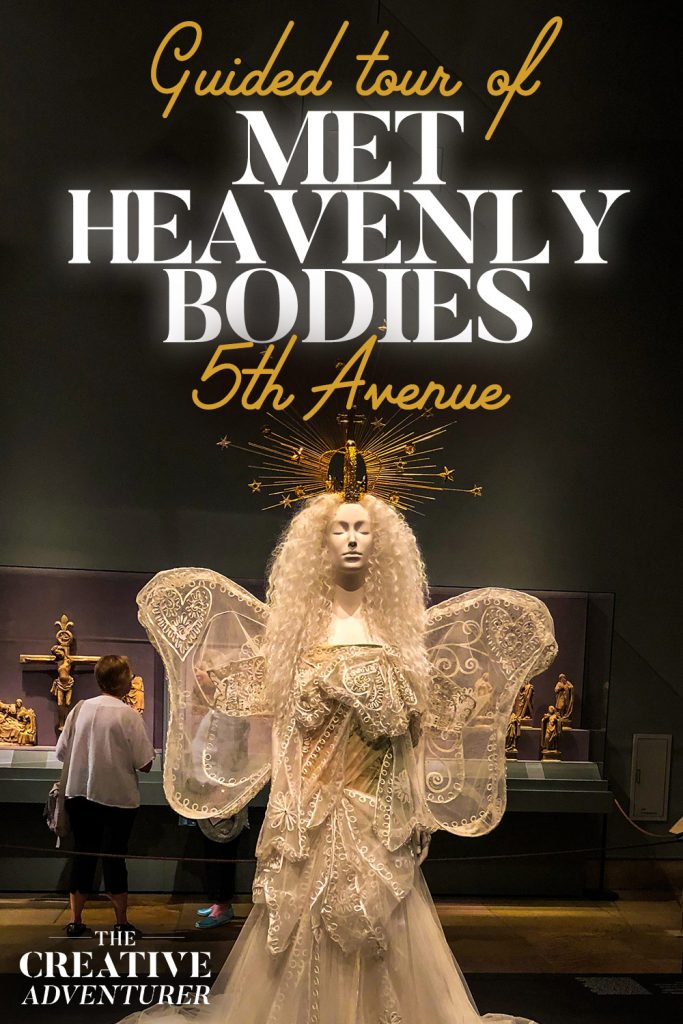


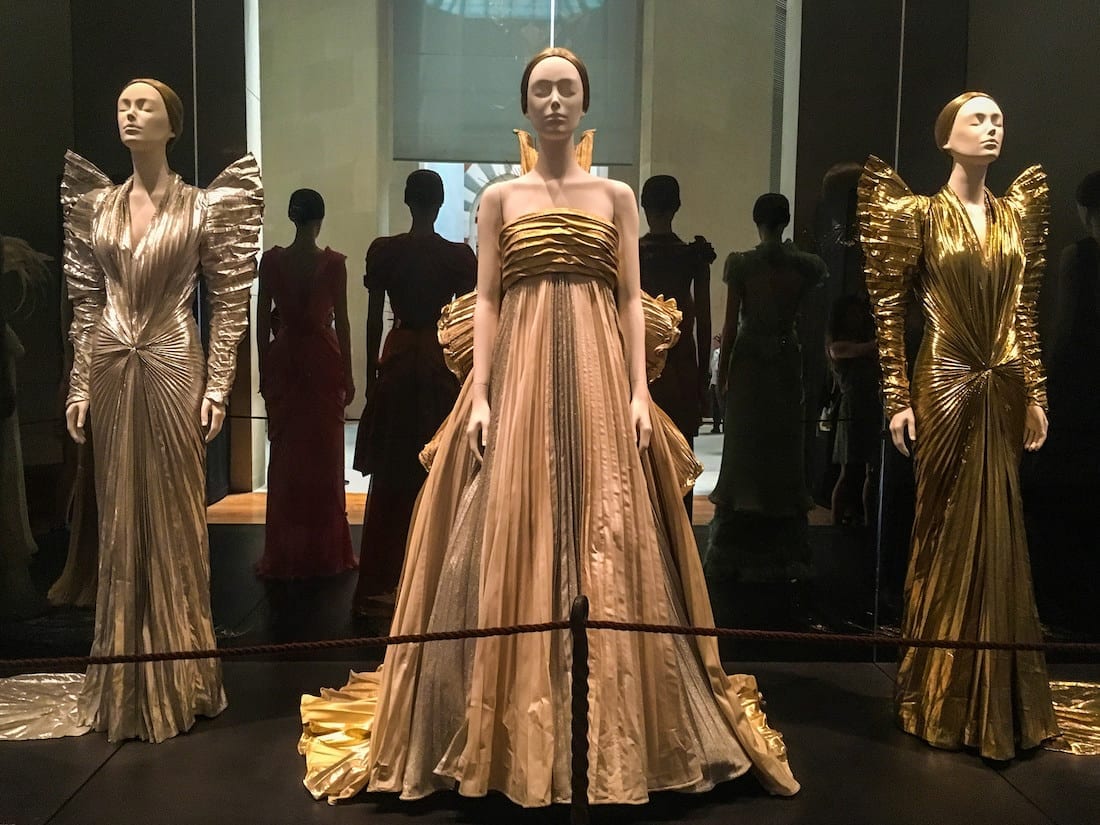
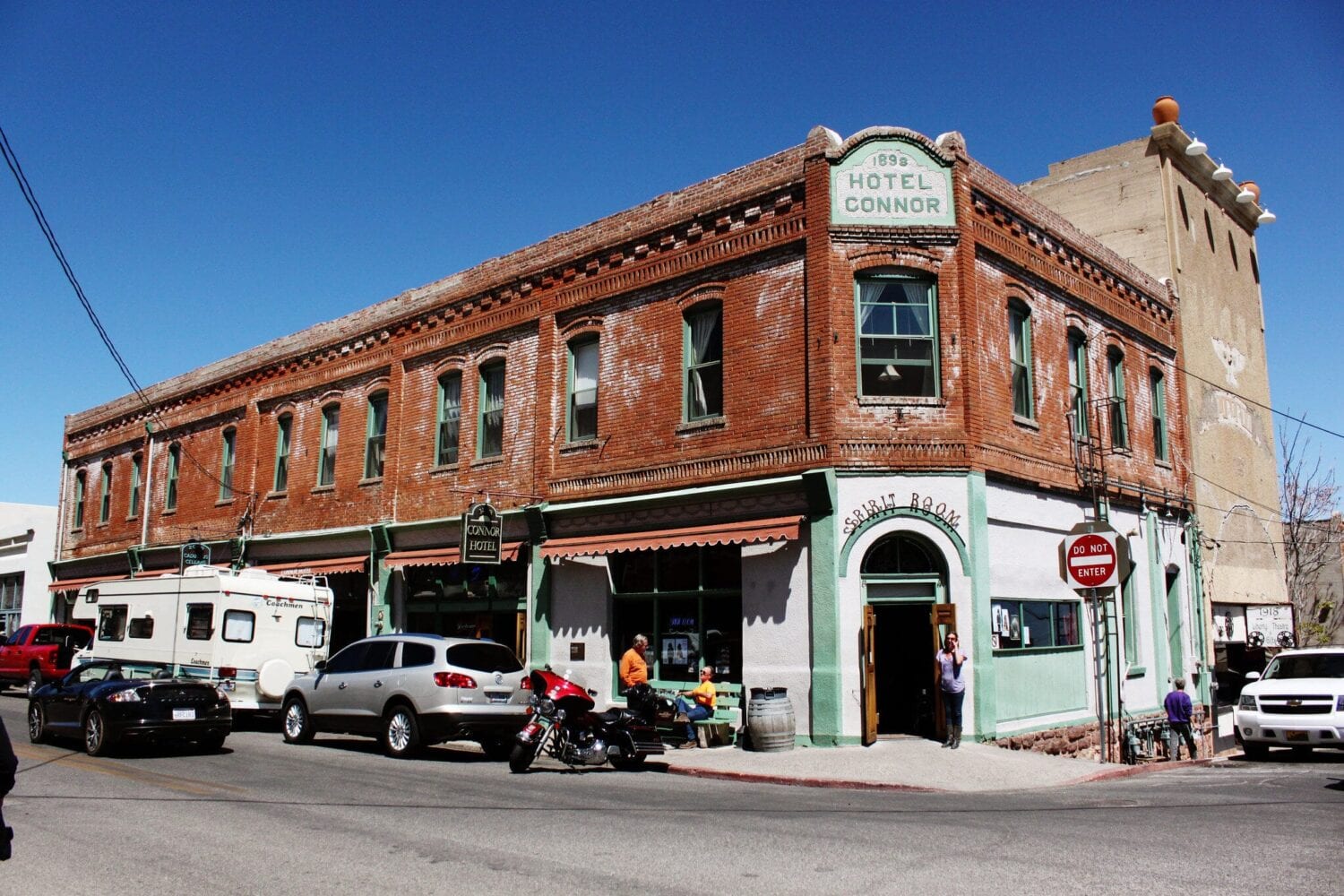
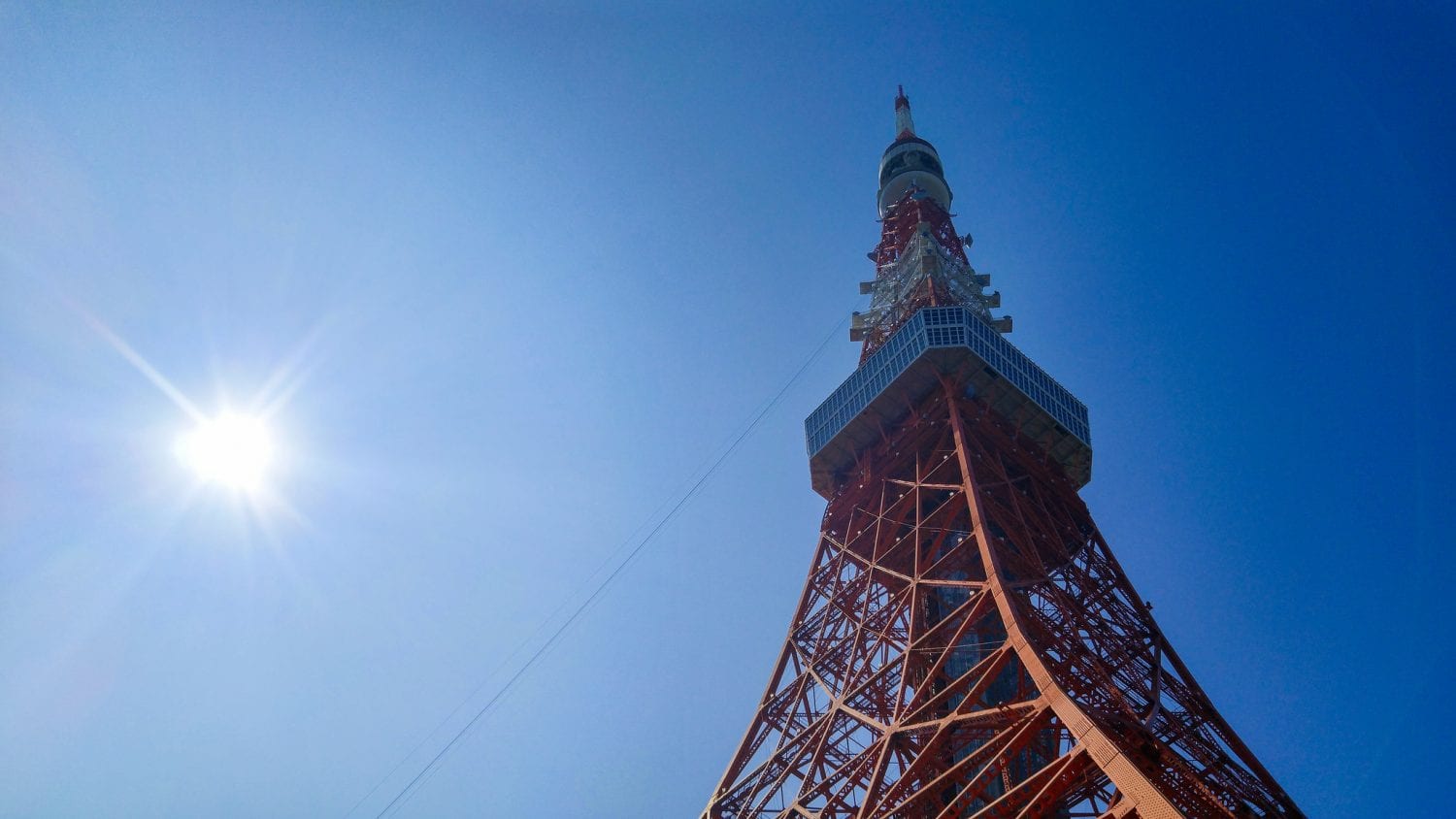
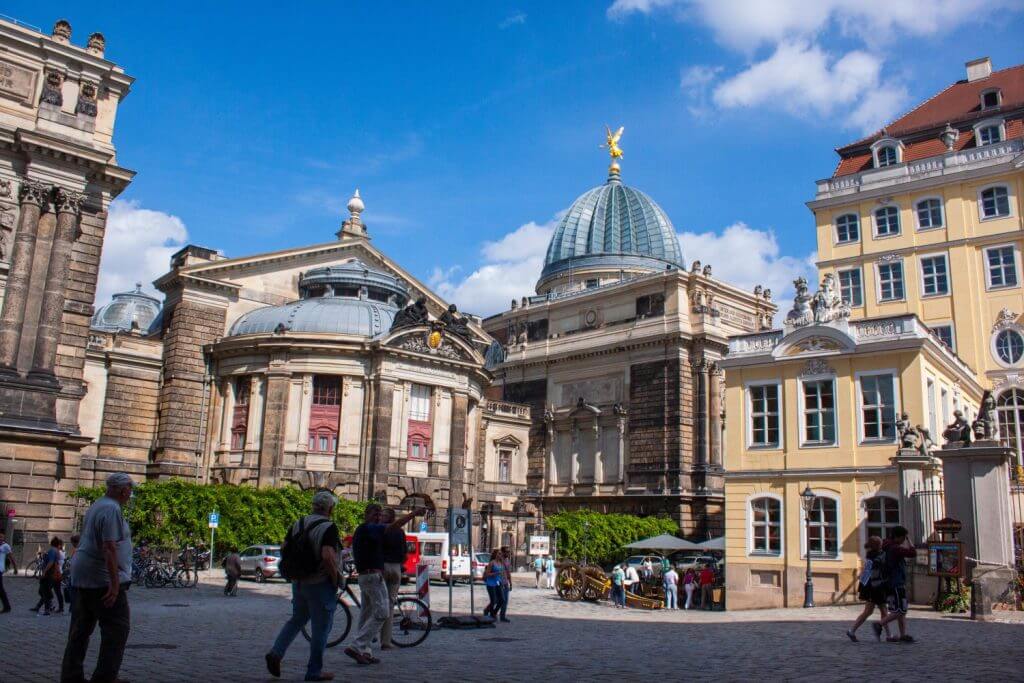
Leave a Comment